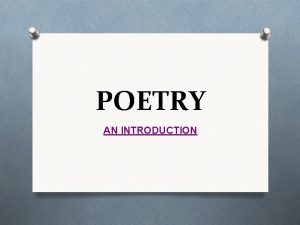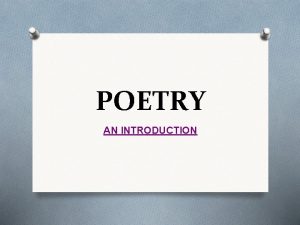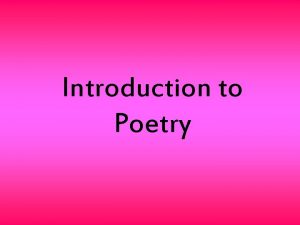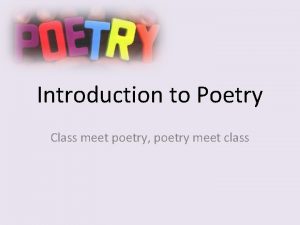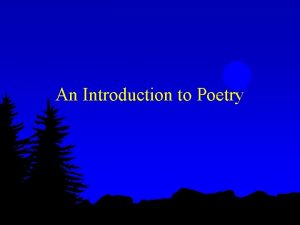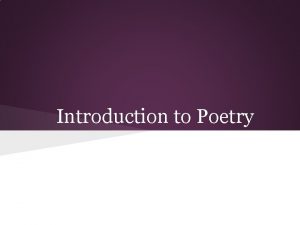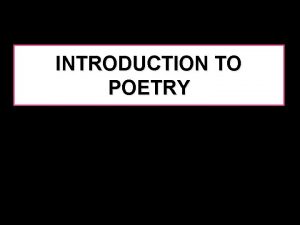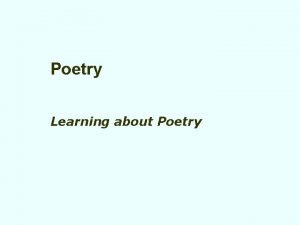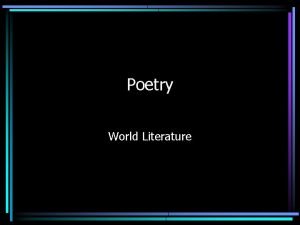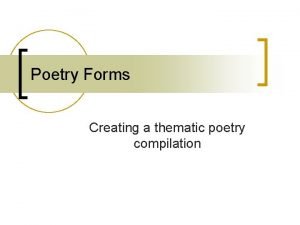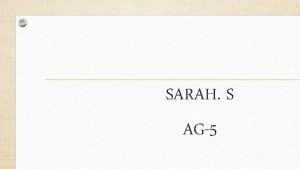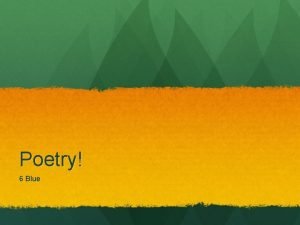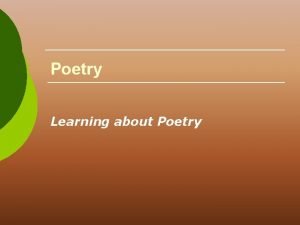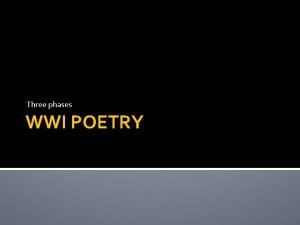Introduction to Poetry Goals for Poetry I unit

































- Slides: 33

Introduction to Poetry

Goals for Poetry I unit: �Discuss poetry using poetic terminology. �Use TPCASTT as a tool for deeper understanding �Demonstrate knowledge of the sonnet’s structure by writing one �Become familiar with the AP multiple choice poetry test �Demonstrate the ability to explicate poetry in the essay format

Poetry and the AP Test �Forty-five percent of the test is comprised of poetry related questions and writing. �AP readers do not expect a 5 paragraph essay. (This structure can shackle your thoughts. ) �Spend at least 20 minutes reading the poem and annotating before you begin writing the essay. �A line number means little to a reader. Don’t waste precious time to count and insert the line. Instead use an apt reference in quotation marks.

Six Basic Areas of Study 1. 2. Meter—syllables & stress Rhyme—creates humor or enhances meter (Meter and rhyme are the music of poetry) Poetic structure—lines and stanzas Imagery—established through figures of speech and diction 5. Intent—to tell a story (narration), to honor a person or thing (lyric), or portray another POV (dramatic) 6. Tone—established by diction 3. 4.

1. METER (two syllables) Upon His Departure Money Thus I (1 metrical foot) Pass by And die: As One, Unknown, And gone: I’m made A shade And laid I’th’ grave; There have My cave. Where tell I dwell, Farewell. (Trochee meter) Workers earn it, (2 metrical feet) Spendthrifts burn it, Bankers lend it Women spend it, Forgers fake it, Taxes take it, Dying leave it, Heirs receive it, Thrifty save it, Misers crave it, Robbers seize it, Rich increase it, Gamblers lose it… I could use it. (Iambic dimeter)

Lengths of metrical feet �Meter �Dimeter �Trimeter �Tetrameter �Pentameter �Hexameter � 2 syllables � 4 syllables � 6 syllables � 8 syllables � 10 syllables � 12 syllables

Match the stress pattern with these three examples of tetrameter (4 feet). 1. "And the sheen of their spears was like stars on the sea" 2. "Because I could not stop for Death" 3. "Peter, Peter , pumpkin-eater" 4. “Babes sleep, teens dream, men sigh--we die. ” A. Iambic tetrameter (da DUM) B. Trochaic tetrameter (DUM da) C. Anapestic tetrameter (da da DUM) D. Spondee (DUM, DUM)

KEY 1. "And the sheen of their spears was like stars on the sea” C. Anapestic 2. "Because I could not stop for Death" A. Iambic 3. "Peter, pumpkin-eater” B. Trochaic 4. “Babes sleep, teens dream, men sigh—we die. ” D. Spondee

2. Rhyme—gives resolution Feminine— 2 syllables (can create comic tone as in limericks or add to rhythm as in rap. ) Dreaming with a watering mouth, Wishing for a better life for my daughter and spouse, In this slaughtering house, caught up in bouts… --Eminem Masculine—final syllable rhymes The boy found a dog. It was really a hog. Internal rhyme—words within line rhyme The boy had a toy. Near rhyme—close but not perfect One short sleep past, we wake eternally, And death shall be no more; death, thou shalt die.

3. Poetic Structure (Stanza Forms &Syntax) �Assignment �Cut up your words. �Create a poem by gluing the words to a sheet of paper. �You can work alone or with a partner. �We will share a few poems on the board.

Original Poem Cocoon The little caterpillar creeps Awhile before in silk it sleeps. It sleeps awhile before it flies. And flies awhile before it dies. And that’s the end of three good tries.

Thinking about the Structure: Stanza Forms & Syntax � How does the line length affect the poem? � Is there enjambment? (Run-on clauses draws us to next line—creates flow. ) � Does the line length change dramatically? � What has the poet done with stanza breaks, or stanza length? � Look for spacing, punctuation and capitalization choices. � Does the poem use rhyme? How so? Is there a pattern? � Are there omissions or repetitions of sounds, letters or words? (Anaphora—repetition of the initial word in several successive lines: “I have a dream…”)

William Carlos Williams (How does the structure of the poem enhance meaning? ) The Red Wheel Barrow so much depends upon a red wheel barrow glazed with rain water beside the white chickens.

4. Imagery *Personification Figurative Language: Creativity with Words Metaphor/Simile Applying human traits to an object: “the house shut its eyes” Personification with an abstraction or someone dead— ”Death, be not proud…” Likening one thing to another Analogy Extended metaphor—ship in Creon’s speech Conceit Unlikely extended metaphor—kings are buckets Metonymy (mə-tä-nə-mē) A single name stands for more—”press” stands for journalism, “golden arches”—Mc. Donalds Synecdoche (sə-nek-də-kē) A more specific type of metonomy: the part means the whole. “A set of wheels, all hands on deck, the redneck” Apostrophe

Imagery (cont. ) Allusion Reference to famous person or art Paradox A seemingly contradictory statement Oxymoron A contradictory phrase: “icy heat” Hyperbole & Understatement Overstatement or—exaggeration -minimizing (Litotes) Irony Opposite of what’s expected Symbol Synesthesia (si-nəs-thē-zhē-ə) An object takes on greater meaning. Mixing of senses (color/sound or taste/touch) “screaming yellow tie” or “sour wind”

Imagery Exercise--Synesthesia �Place the concept of “fear” into the following categories: Color Sound or instrument Taste or food Animal Body of water Piece of furniture Famous Person Article of clothing Country

Adding to Imagery in small ways Onomatopoeia The word’s sound imitates the actual sound: “ululating” or “pop” Alliteration Repetition of initial consonant sound: “sails did sigh like sedge” Assonance Consonance Caesura Repetition of vowel sounds: “Be near me when my light is low. ” Repetition of internal consonant sounds: “Linger no longer with anger. ” A complete pause in a line of poetry.

5. Intent �Narrative Tells story, has crisis or turning point, uses formula or stock phrases repeated, images lead toward a crisis and give consequence �Dramatic Writer adopts another’s voice and portrays character (soliloquy, dramatic monologue, epistolary) (Or the narrator may not be a person at all. ) �Lyric (Ode) A private, visionary or emotional poem, love poem, encomium (poem of praise), elegy (death song), meditative poem

“To An Athlete Dying Young” Lyric

6. Tone �Writer’s attitude toward subject shown through Rhythm Sounds Images and mostly--Word selection

Identifying tone in diction �Group the following words into two groups of six according to tone. freedom sparkling torrid sleek skull sheltered curse veins rodents wrath love tiller �freedom, love, sleek, sparkling, sheltered, tiller �skull, wrath, rodent, veins, curse, torrid

Practicing using tone �Group 1—write a 3 line poem reflecting humility �Group 2—write a 3 line poem reflecting humor �Group 3—write a 3 line poem reflecting rage �Group 4—write a 3 line poem reflecting silly love �Group 5—write a 3 line poem reflecting arrogance

Assignment �Please read each poem before class. Orange book. �Write a 3 sentence analysis for each due on _____. 1. “Sir Patrick Spence” (546). 2. “May He Lose His Way” (570). 3. The River Merchant’s Wife” (600). 4. “Then” (654). 5. “In Absence from Becchina” (676). 6. “Seeing Hsia Chan Off by River” (679). 7. “Olympian II” (758). 8. “Six Tanka” (763). 9. “The Complaint of Chaucer to His Purse” (808).

Common Structures

The Ballad � 4 line stanza, iambic tetrameter, short lines to give speed, good for narration, one scene per quatrain Ballad Of A Thin Man by Bob Dylan You walk into the room With your pencil in your hand You see somebody naked And you say, “Who is that man? ”

Shakespearean Sonnet 18 Shall I compare thee to a summer’s day? Thou art more lovely & more temperate; Rough winds do shake the darling buds of May And summer’s lease hath all too short a date; Sometimes too hot the eye of heaven shines, And often is his gold complexion dimmed’ And every fair from fair sometime declines, By chance, or nature’s changing course, untrimmed. But thy eternal summer shall not fade Nor lose possession of that fair thou owest; Nor shall Death brag thou wanderest in his shade. When in eternal lines to time thou growest— So long as men can breathe, or eyes can see, So long lives this, & this gives life to thee. --Shakespeare

The Italian Sonnet: Death DEATH Death be not proud, though some have called thee Mighty and dreadful, for, thou art not so, For, those, whom thou think'st, thou dost overthrow, Die not, poor death, nor yet canst thou kill me. From rest and sleep, which but thy pictures bee, Much pleasure, then from thee, much more must flow, And soonest our best men with thee doe go-Rest of their bones, and souls’ delivery! Thou art slave to fate, chance, kings, & desperate men, And dost with poison, war, and sickness dwell, And poppy, or charms can make us sleep as well, And better then thy stroke; why swell'st thou then; One short sleep past, we wake eternally, And death shall be no more; death, thou shalt die. ----John Donne

The Sonnet Assignment �Three quatrains (4 lines) followed by a couplet (2 rhyming lines). �The rhyme scheme is abab cdcd efef gg �Use iambic pentameter—five accented beats per line (da Dum). �Focus on a specific subject (your assigned classmate), but keep the name a secret. �We will share these sonnets with the class to see if your peers can guess whom your sonnet describes.

Answer these Questions for the sonnet assignment. 1. 2. 3. 4. 5. 6. 7. 8. 9. 10. 11. 12. 13. 14. What is your favorite article of clothing? Where is your favorite place to hang out? What actor, teacher, athlete, politician, musician, or animal would you like to be? Where do you shop? What is your best physical feature? What is your best character quality? What actor would portray you in a movie? What do you grab if there’s a fire? What’s your ultimate goal in life? It’s your last meal—what do you order? What is something few people know about you? What do you love most in others? What are you pretty good at doing? What activities do you like and why?

TPCASTT Strategy �Title—What does the title suggest? �Paraphrase—After reading the poem through once, translate each line to ensure close reading. �Connotation—In this context, what words take on unique meanings? �Attitude—Who is the speaker? �Shift—Where is the climax, the kicker, the surprise, the clue to theme, the break in pattern? �Title—Does the title now take on new meaning? �Theme—What message did you discover?

Other Forms �Blank verse—iambic pentameter, no rhyme �Free verse—no rhyme or meter, emphasis on diction �Ode—a poem of praise in which the poet designs his/her own stanza form and then holds to it �Asian verse— Haiku: 3 lines, emphasis on imagery Tanka: 5 lines (31 words) �Clerihews— 4 -lined funny rhyme about a person � Our art teacher, Mr. Shaw, /Really knows how to draw. /But his sexy paintings/ Have caused many faintings. �Epigram—Short poem (writing on a tombstone)

Villanelle— 19 line dance song sung by troubadour Villenelle of Change Since Persia fell at Marathon, The yellow years have gathered fast: Long centuries have come and gone. And yet (they say) the place will don A phantom fury of the past, Since Persia fell at Marathon; And as of old, when Helicon Trembled and swayed with rapture vast (Long centuries have come and gone), This ancient plain, when night comes on, Shakes to a ghostly battle-blast, Since Persia fell at Marathon. But into soundless Acheron The glory of Greek shame was cast: Long centuries have come and gone, The suns of Hellas have all shone, The first has fallen to the last: — Since Persia fell at Marathon, Long centuries have come and gone. � 5 triplets and a quatrain � 2 rhymes � 1 st line repeated 3 times � 3 rd line repeated 3 times � 1 st line and 3 rd line conclude poem

Am. Literary Movements (Before multiple choice poetry test) �Classicism (c. 1750)—reason—Thomas Paine �Romanticism (c. 1800)—emotion—Poe �Realism (c. 1850)—reality—Twain �Naturalism (c. 1850)—nature—Darwin, Jack London �Existentialism (c. 1900)—individual—Dostoyevsky
 Strategic goals tactical goals operational goals
Strategic goals tactical goals operational goals Strategic goals tactical goals operational goals
Strategic goals tactical goals operational goals General goals and specific goals
General goals and specific goals Motivation in consumer behaviour
Motivation in consumer behaviour Unit 10, unit 10 review tests, unit 10 general test
Unit 10, unit 10 review tests, unit 10 general test Kontinuitetshantering
Kontinuitetshantering Typiska novell drag
Typiska novell drag Tack för att ni lyssnade bild
Tack för att ni lyssnade bild Vad står k.r.å.k.a.n för
Vad står k.r.å.k.a.n för Shingelfrisyren
Shingelfrisyren En lathund för arbete med kontinuitetshantering
En lathund för arbete med kontinuitetshantering Underlag för särskild löneskatt på pensionskostnader
Underlag för särskild löneskatt på pensionskostnader Personlig tidbok
Personlig tidbok Sura för anatom
Sura för anatom Vad är densitet
Vad är densitet Datorkunskap för nybörjare
Datorkunskap för nybörjare Stig kerman
Stig kerman Debattartikel struktur
Debattartikel struktur För och nackdelar med firo
För och nackdelar med firo Nyckelkompetenser för livslångt lärande
Nyckelkompetenser för livslångt lärande Påbyggnader för flakfordon
Påbyggnader för flakfordon Vätsketryck formel
Vätsketryck formel Offentlig förvaltning
Offentlig förvaltning Jag har nigit för nymånens skära
Jag har nigit för nymånens skära Presentera för publik crossboss
Presentera för publik crossboss Jiddisch
Jiddisch Kanaans land
Kanaans land Treserva lathund
Treserva lathund Epiteltyper
Epiteltyper Bästa kameran för astrofoto
Bästa kameran för astrofoto Cks
Cks Byggprocessen steg för steg
Byggprocessen steg för steg Bra mat för unga idrottare
Bra mat för unga idrottare Verktyg för automatisering av utbetalningar
Verktyg för automatisering av utbetalningar





































